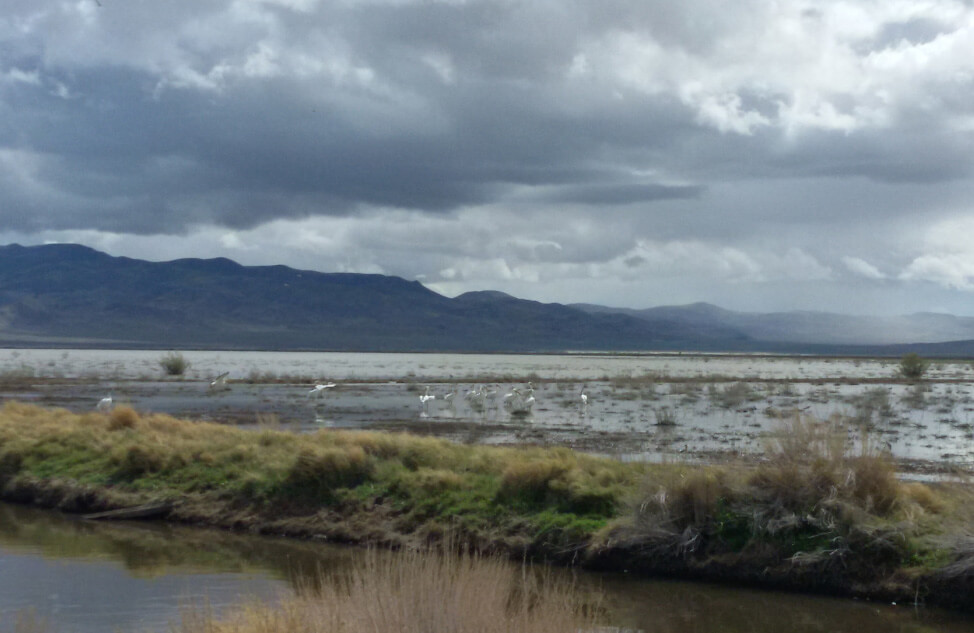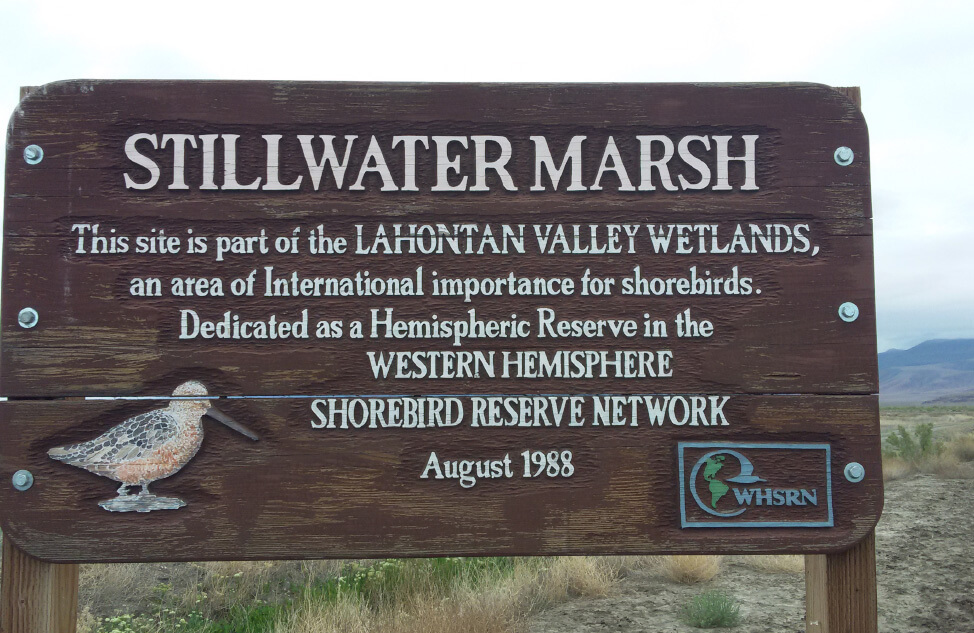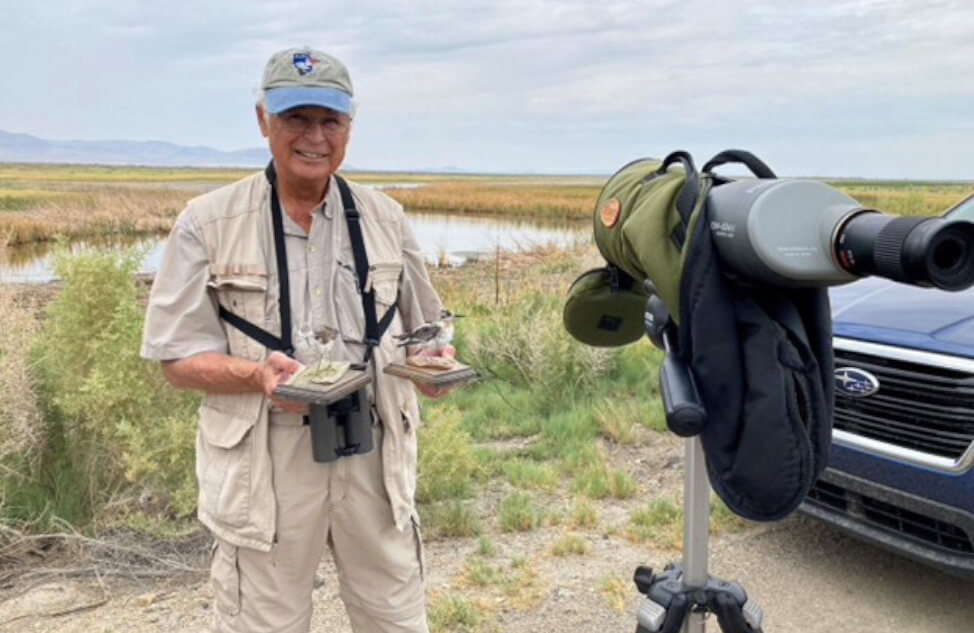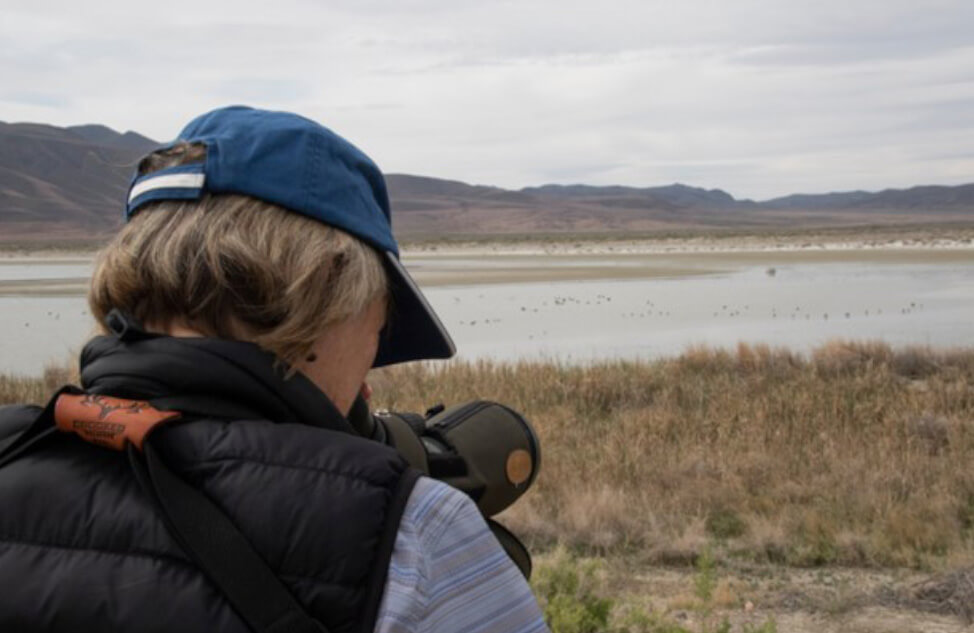By: Laura Chamberlin – Advisor, WHSRN Executive Office
Seventy miles east of Reno, Nevada, surrounded by desert, lies the Lahontan Valley Wetlands Complex, a wetland oasis that is home to many waterbirds including 22 shorebird species. Receiving its water from Carson River, which flows from the Sierra Nevada mountain range, Lahontan Valley is dependent on precipitation from the mountains. When snow pack melts in the spring, higher volumes of water are delivered to Lahontan Valley just in time for spring migration.
The Lahontan Valley Wetlands was designated as a Western Hemisphere Shorebird Reserve Network (WHSRN) site in 1988 for its large numbers of Long-billed Dowitchers and other shorebirds. Surveys in recent years indicate that more than 72,000 shorebirds use the Lahontan Valley during fall and more than 112,000 during spring confirming its continued importance in the Great Basin.
Water quantity and timing of water availability are the greatest threats to this WHSRN site, like many important sites in the western United States. In addition to habitat, water is in high demand for communities, agriculture, and grazing. Water diversions for upstream users can impact the inflows of Carson River, which then impacts the fresh and alkaline wetlands of Lahontan Valley. Today, 84% of the native wetlands have been lost (Wisely et al. 2017). The challenge of water is further complicated with the limited capacity of the overstretched and underfunded land managers to plan and manage these habitats.

Carson Lake Wildlife Management Area part of the Lahontan Valley Wetlands WHSRN Site. Photo courtesy of Manomet.
In 2021, National Audubon Society, Manomet, the U.S. Fish and Wildlife Service (USFWS), the Nevada Department of Wildlife (NDOW), and Lahontan Audubon Society (LAS) began working together to identify management opportunities for shorebird habitat and to increase shorebird and habitat monitoring capacity at Nevada’s Lahontan Valley Wetlands site. The project activities included mapping historic and current shorebird habitat, creating priority shorebird species profiles, establishing a volunteer-based long-term monitoring program, and identifying opportunities to enhance shorebird habitat through on-the-ground management.
The volunteer monitoring program has now served through 2021-22 and will continue in 2023. Over 30 volunteers have provided additional hours which has increased the number and frequency of surveys conducted. The results of these volunteer surveys will contribute to a larger, longer-term dataset that can be used to inform and enhance management of water resources and wetlands in Lahontan Valley.
The project also created eleven species habitat profiles to provide land managers with guidance on how to target management actions for certain species. The profiles identify habitat conditions, including water depth and vegetation types, and the timing of conditions necessary to support shorebird use. Development of the habitat profiles was based on a literature review of published scientific studies and close consultation with local and regional wildlife managers and biologists. Recommendations in the profiles can then be applied to on-the-ground management. Partners also explored opportunities to influence management with an assessment of water management infrastructure for the Carson Lake Wildlife Management Area and the creation of a decision support tool to provide water allocation recommendations for six wetland units at Stillwater National Wildlife Refuge.


Left: Stillwater National Wildlife Refuge part of the Lahontan Valley Wetlands WHSRN Site. Right: Alan Gubanich, a monitoring volunteer from Lahontan Audubon Society. Photo courtesy of Manomet (left) and Mike Goddard (right).
Across the 11 featured species, there is a range of habitat needs so management recommendations varied depending on the target species, but several key practices were highlighted for consideration at Lahontan Valley or similar sites. Optimal conditions for migrating shorebirds result from wetlands receiving water prior to arrival of birds, and then maintaining complexes with a variety of water levels during the migratory windows of March to May and July to September. Managed wetlands such as impoundments and ponds can optimize foraging opportunities by drawing down water levels to maintain areas with water depths ranging from 0 to 20 centimeters. Grazing activity can limit the vegetation height and density that grassland species in this region need to have controlled for high-quality nesting and foraging habitat, but these species will avoid areas with continuous season-long grazing so management recommendations suggest the incorporation of rotational grazing. Overall, one of the greatest themes for many of the species is the importance of maintaining a network of diverse habitats to maintain a high-quality migration or breeding site.
The objectives and actions at Lahontan Valley are nested within a larger effort to conserve saline lakes in the arid West and support management of habitat for shorebirds. The species habitat profiles can now be leveraged at a regional scale by sharing the profiles with wildlife managers and biologists at wetlands and saline lakes in the Great Basin. When these species habitat profiles are combined with other lessons learned about habitat modeling and volunteer monitoring, Lahontan Valley will serve as a model of collaboration for other sites in the region.

Volunteer Valerie Anderson counts a mixed flock of shorebirds at Stillwater National Wildlife Refuge. Photo: Max Malmquist
As has been the norm in recent years, 2023 will be another year of extremes for Lahontan Valley. This winter has seen record-breaking snowfall in the Sierra Nevada which will provide high volumes of water for the Lahontan Valley during the spring melt, but too much water can cause flooding and damage water management infrastructure. It’s too soon to know what this winter’s snow will bring for Lahontan Valley, but we do know that managers and volunteers are ready to work together, utilizing the best science, to ensure that the best possible habitat is available for shorebirds.
Support for this work is made possible by the National Fish and Wildlife Foundation, the BAND Foundation, and the Bobolink Foundation. For more information about the species habitat profiles contact Shiloh Schulte, Manomet and for more information about the collaboration at Lahontan Valley contact Max Malmquist, National Audubon Society.
Cover Photo: Carson Lake Wildlife Management Area part of the Lahontan Valley Wetlands WHSRN Site. Photo courtesy of Manomet.






